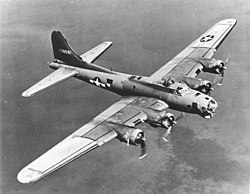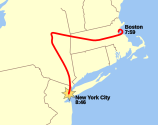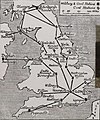Portal:Aviation
| Main page | Categories & Main topics |
|
Tasks and Projects |
The Aviation Portal

Aviation includes the activities surrounding mechanical flight and the aircraft industry. Aircraft includes fixed-wing and rotary-wing types, morphable wings, wing-less lifting bodies, as well as lighter-than-air aircraft such as hot air balloons and airships.
Aviation began in the 18th century with the development of the hot air balloon, an apparatus capable of atmospheric displacement through buoyancy. Clément Ader built the "Ader Éole" in France and made an uncontrolled, powered hop in 1890. This is the first powered aircraft, although it did not achieve controlled flight. Some of the most significant advancements in aviation technology came with the controlled gliding flying of Otto Lilienthal in 1896; then a large step in significance came with the construction of the first powered airplane by the Wright brothers in the early 1900s. Since that time, aviation has been technologically revolutionized by the introduction of the jet which permitted a major form of transport throughout the world. (Full article...)
Selected article
The aircraft crashed into the North Tower of the World Trade Center at 08:46 local time; the impact killed all 92 people aboard, including the hijackers. Many people in the streets witnessed the collision, and Jules Naudet captured the impact on video. News agencies began to report on the incident soon after and speculated that the crash had been an accident. The impact and subsequent fire caused the North Tower to collapse, which resulted in thousands of additional casualties. During the recovery effort at the World Trade Center site, workers recovered and identified dozens of remains from Flight 11 victims, but many other body fragments could not be identified. (Full article...)
Selected image
Did you know
...that Chris Phatswe committed suicide by crashing his Air Botswana plane into two other planes belonging to the airline, effectively crippling operations? ...that the Blohm und Voss Bv 144 was an attempt by Nazi Germany to develop an advanced commercial airliner for post-war service? ... that while flying accidents were commonplace at RAAF training establishments during World War II, No. 8 Service Flying Training School's first fatality was from drowning?
General images -
In the news
- May 29: Austrian Airlines cancels Moscow-bound flight after Russia refuses a reroute outside Belarusian airspace
- August 8: Passenger flight crashes upon landing at Calicut airport in India
- June 4: Power firm helicopter strikes cables, crashes near Fairfield, California
- January 29: Former basketball player Kobe Bryant dies in helicopter crash, aged 41
- January 13: Iran admits downing Ukrainian jet, cites 'human error'
- January 10: Fire erupts in parking structure at Sola Airport, Norway
- October 27: US announces restrictions on flying to Cuba
- October 3: World War II era plane crashes in Connecticut, US, killing at least seven
- September 10: Nevada prop plane crash near Las Vegas leaves two dead, three injured
- August 6: French inventor Franky Zapata successfully crosses English Channel on jet-powered hoverboard
Related portals
Associated Wikimedia
The following Wikimedia Foundation sister projects provide more on this subject:
-
Commons
Free media repository -
Wikibooks
Free textbooks and manuals -
Wikidata
Free knowledge base -
Wikinews
Free-content news -
Wikiquote
Collection of quotations -
Wikisource
Free-content library -
Wikiversity
Free learning tools -
Wikivoyage
Free travel guide -
Wiktionary
Dictionary and thesaurus
Selected biography
Born in Mannheim, Wick joined the Luftwaffe in 1936 and was trained as a fighter pilot. He was assigned to Jagdgeschwader 2 "Richthofen" (JG 2—2nd Fighter Wing), and saw combat in the Battles of France and Britain. Promoted to Major in October 1940, he was given the position of Geschwaderkommodore (wing commander) of JG 2—the youngest in the Luftwaffe to hold this rank and position. He was shot down in the vicinity of the Isle of Wight on 28 November 1940 and posted as missing in action, presumed dead. By then he had been credited with destroying 56 enemy aircraft in aerial combat, making him the leading German fighter pilot at the time. Flying the Messerschmitt Bf 109, he claimed all of his victories against the Western Allies.
Selected Aircraft

The Boeing B-17 Flying Fortress is an American four-engine heavy bomber aircraft developed for the U.S. Army Air Corps (USAAC). Competing against Douglas and Martin for a contract to build 200 planes, the airplane outperformed both the other entries and the Air Corps' expectations. Although losing the contract due to an accident, the Air Corps was so in favor of the B-17 that they ordered 13 B-17s regardless. Evolving through numerous design stages, from B-17A to G, the Flying Fortress is considered the first truly mass-produced large aircraft. From its pre-war inception, the USAAC touted the aircraft as a strategic weapon; it was a high-flying, long-ranging potent bomber capable of defending itself. With the ability to return home despite extensive battle damage, its durability, especially in belly-landings and ditchings, quickly took on mythical proportions.
The B-17 was primarily involved in the daylight precision strategic bombing campaign of World War II against German industrial targets. The United States Eighth Air Force based in England and the Fifteenth Air Force based in Italy complemented the RAF Bomber Command's night-time area bombing in Operation Pointblank, which helped secure air superiority over the cities, factories and battlefields of Western Europe in preparation for Operation Overlord. The B-17 also participated, to a lesser extent, in the War in the Pacific.
Today in Aviation
- 2011 – Launch of USA-225,(Rapid Pathfinder Prototype ‘RPP’ or NRO Launch 66 ‘NROL-66‘), American satellite to perform technology demonstration and development experiments, including advanced dosimeters to characterize the space environment from a 1,200 km low Earth orbit.
- 2009 – FedEx closes its first hub for the first time in history when their Asian-Pacific center at Subic Bay International Airports ceases operations, which were then transferred to Guangzhou Baiyun Airport in southern China.
- 2008 – First flight of the New Zealand design Falcomposite Furio, a carbon-fibre kit aircraft.
- 1998 – Washington National Airport is renamed Ronald Reagan National Airport.
- 1998 – Death of Anthony W. “Tony” LeVier, American air racer and test pilot for the Lockheed Corporation.
- 1998 – Andy Nelson and navigator Bertrand Piccard, lands the Breitling Orbiter II settind the world record for endurance at nine days and 17 hours – or, to be exact, 233 hours, and 55 min in an attempt of a round the world flight aborted as China did not did not allow them to fly avor the country.
- 1996 – Birgenair Flight 301, a Boeing 757, with 189 people on board, crashes into the ocean off Puerto Plata in the Dominican Republic shortly after taking off. All passengers and crew are killed.
- 1992 – A Kentucky Air National Guard Lockheed C-130B Hercules, 58-0732, c/n 3527, of the 165th Tactical Airlift Squadron, stalls and crashes into the JoJo's restaurant and Drury Inn while practicing touch and go maneuvers at the Evansville, Indiana Airport. All five crew members and nine people on the ground were killed. Several others were injured.
- 1991 – Two U. S. Air Force F-15 C Eagles of the 36th Tactical Fighter Wing use AIM-9 Sidewinder air-to-air missiles to shoot down four Iraqi Air Force aircraft – Two Mikoyan-Gurevich MiG-21 s (NATO reporting name “Fishbed”) and two Sukhoi Su-25 s (NATO reporting name “Frogfoot”) – Fleeing to Iran at an altitude of about 100 feet (30 m).
- 1990 – A USAF General Dynamics F-111E-CF, 68-0001, known as "Balls 1", c/n A1-170 / E-11, out of RAF Upper Heyford, crashes into the North Sea off the east coast of England during a routine training mission, killing two crew. The Third Air Force identified the crew as pilot Capt. Clifford W. Massengill, 30, of Edenton, North Carolina, and WSO 1st Lt. Thomas G. Dorsett, 26, of Pensacola, Florida.
- 1983 – Death of Cyril Nelson ‘Kit’ Lowe, British WWI flying ace, International Rugby player and supposedly the inspiration for W. E. Johns’ character “Biggles”.
- 1978 – Senator Howard Cannon of Nevada introduces the airline Deregulation Act, which would be passed the next October.
- 1975 – Death of Air Chief Marshal Sir Keith Rodney Park GCB, KBE, MC & Bar, DFC, RAF, New Zealand soldier, WWI flying ace and WWII Royal Air Force commander.
- 1972 – Canadian airport radar and communications technicians strike, halting all but military air traffic until March 2.
- 1971 – Alan Shepard makes a historical golf drive on the moon.
- 1968 – First flight of the Canadair CF-5 (officially designated the CF-116 Freedom Fighter), Canadair licensed-built version of the American Northrop F-5 Freedom Fighter aircraft primarily for the Canadian Forces.
- 1966 – Death of Bertram Hutchinson Smyth, British WWI flying ace.
- 1965 – LAN Chile Flight 107, a Douglas DC-6, crashed shortly after takeoff from Santiago-Los Cerrillos Airport in Santiago, Chile. All 87 passengers and crew on board are killed.
- 1964 – United Airlines puts the Boeing 727 into service, 5 days after delivery.
- 1962 – First flight of the FMA IA 50 Guaraní I, Argentine prototype utility aircraft, refined version of the Huanquero.
- 1961 – Birth of Col. Yuri Ivanovich Onufriyenko, Ukrainian-Russian cosmonaut.
- 1959 – First launch of a Martin Marietta SM-68 A/HGM-25 A Titan I, US first multistage ICBM.
- 1958 – In the Munich air disaster, a British European Airways Airspeed Ambassador operating as Flight 609 crashes during takeoff from Munich-Riem Airport, killing 23 of 44, including eight Manchester United footballers.
- 1956 – TWA Captain William Judd flew his Cessna 180 “Star of the Red Sea” non-stop from New York to Paris – A distance of more than 3600 miles across the North Atlantic.
- 1952 – Martin P4M-1Q Mercator, BuNo 124371, based in Port Lyautey, French Morocco, staging out of Nicosia, Cyprus. Operationally attached to NCU-32G. Returning from the Black Sea made an open ocean dead-stick landing east of Cyprus. Lt. Robert Hager, killed, 14 survivors rescued by HMS Chevron.
- 1948 – A new 100 km closed circuit speed record of 542mph is established by Squadron Leader W. A. Waterton, flying a Gloster Meteor IV.
- 1945 – The United States Coast Guard’s efforts to develop the United States Department of the Navy’s capability to use the helicopter as an antisubmarine warfare platform come to an end.
- 1944 – American forces complete the conquest and occupation of Kwajalein Atoll.
- 1943 – First flight of the Supermarine Type 322, a British prototype carrier borne torpedo, dive bomber and reconnaissance aircraft single engined monoplane.
- 1941 – Boeing B-17B Flying Fortress, 38-216, c/n 2009,[56] crashes near Lovelock, Nevada while en route to Wright Field, Ohio, killing all eight on board. Pilot Capt. Richard S. Freeman had shared the 1939 MacKay Trophy for the Boeing B-15 flight from Langley Field, Virginia via Panama and Lima, Peru at the request of the American Red Cross, for delivering urgently needed vaccines and other medical supplies in areas of Chile devastated by an earthquake. General Order Number 10, dated 3 March 1943, announces that the advanced flying school being constructed near Seymour, Indiana is to be named Freeman Field in honor of the Hoosier native.
- 1941 – A Trans-Canada Air Lines Lockheed 14H-2, Fin 38 [CF-TCP] crashed at Armstrong, Ontario. This was the first loss of passenger life for the airline.
- 1938 – Junkers Ju 90 V1, D-AALU, "Der Grosse Dessauer", combination of wings, engines, undercarriage and tail assembly of Junkers Ju 89 V3, Werknummer 4913, mated to a new transport fuselage, broke up in flight while undergoing flutter tests out of Dessau, Germany.
- 1938 – First successful in-flight separation of The Short-Mayo composite (Short S.21 Maia and Short S.20 Mercury seaplane) from the Shorts works at Borstal, near Rochester, Medway.
- 1933 – 6-8 – Gayford and Nicholetts make the first non-stop flight from England to South Africa in a Fairey Long-Range Monoplane. The 5,309 mile (8,544 km) flight is a new distance record. They take 57 hours 25 min.
- 1933 – 6-9 – Jim Mollison flies a de Havilland Puss Moth from the United Kingdom to Brazil, via Senegal, across South Atlantic. He becomes the first person to fly solo across the North and South Atlantics.
- 1933 – First flight of the Kawanishi E7K, a Japanese three-seat biplane reconnaissance floatplane.
- 1931 – Imperial Airways begins scheduled services between England and Africa using Armstrong Whitworth Argosys.
- 1923 – Deutsche Luft-Reederei, Early German Airline, and first German airline to use heavier than air aircraft, ceased operations.
- 1919 – Death of Edgar George Davies, British WWI flying ace, Killed in his SE.5a while trying a high-speed roll over Bickendorf Airfield.
- 1916 – Aircraft from the Imperial Russian Navy Black Sea Fleet’s seaplane carriers Imperator Nikolai I and Imperator Aleksandr I sink the Ottoman collier Irmingard (4,211 grt). Irmingard is the largest ship sunk by air attack in World War I.
- 1916 – The airline Deutsche Luft Reederei flies its first service, which is freight only, between Berlin and Weimar.
- 1896 – Birth of Arthur Clunie “Snowy” Randall, Scottish WWI flying ace.
- 1896 – Birth of Harold Alan Hamersley, Australian WWI fighter ace, Avro test pilot and WWII flying officer.
- 1895 – Birth of Kurt Wolff, Imperial Germany’s WWI fighter ace.
- 1892 – Birth of Guido Keller, Italian WWI pilot, poet and adventurer.
- 1892 – Birth of Ivan Alexandrovich Loiko, Russian WWI flying ace.
- 1890 – Birth of Gottfried von Banfield, most successful Austro-Hungarian WWI naval aeroplane pilot, known as the ‘Eagle of Trieste’. He may have been the only flying ace who flew a flying boat to five or more victories.
- 1883 – Birth of Dmitry Pavlovich Grigorovich, Russian/Soviet aircraft designer.
References
- Shortcuts to this page: Portal:Airplanes • P:AVIA






















































